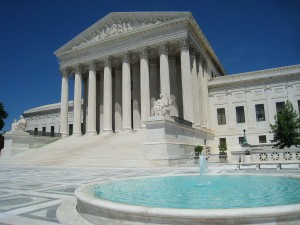Top Federal Crime Lawyer: Specialized Legal Protection for Federal Offenses
Top Federal Crime Lawyer: Specialized Legal Protection for Federal Offenses
Blog Article
Debunking the Refine of Federal Appeals: What You Need to Know
Browsing the complex world of federal allures can commonly feel like passing through uncharted waters for those not familiar with the process. Recognizing the nuances of appellate court territory, the details of filing a notice of allure, offering a compelling brief, and making an influential dental disagreement are vital parts that can considerably impact the outcome of a situation. By untangling the layers of complexity bordering federal allures, people can gain a more clear understanding right into the systems that govern this vital phase of the lawful system.
Comprehending Federal Appeals Refine
Exploring the intricate world of the federal charms process reveals a organized and methodical trip with the judicial system. Federal allures function as a crucial mechanism for evaluating choices made by reduced courts. Recognizing this process is important for any individual associated with legal proceedings at the federal level.
The procedure generally starts with an event dissatisfied with a reduced court's judgment filing a notice of appeal. This activates a review by a greater court, where a panel of courts assesses the legal arguments provided by both celebrations. Briefs laying out the lawful thinking behind each event's position are sent, and oral arguments might be heard to clarify complicated concerns.
The appellate court's choice is based on a thorough assessment of the reduced court's procedures and the debates presented. The judges do not reexamine facts however focus on whether lawful mistakes occurred that impacted the lower court's choice. As soon as the appellate court reaches a choice, it can attest, reverse, remand, or modify the lower court's ruling, giving quality and finality to the lawful conflict. Recognizing this process is vital for navigating the intricacies of federal appeals properly.
Appellate Court Territory Clarified
Appellate court territory refers to the range of instances that a certain appellate court has the power to assess and choose upon. Unlike test courts that hear instances for the first time, appellate courts are limited to assessing choices made by lower courts.
Appellate courts have jurisdiction over particular sorts of situations, commonly those involving lawful errors, procedural concerns, or inquiries of law as opposed to accurate disputes. The territory of appellate courts is typically laid out in laws and regulations that govern the court system. Recognizing appellate court territory is essential for events included in the appeals procedure as it establishes whether a situation is eligible for evaluation and the degree to which the appellate court can intervene in the reduced court's decision.
Declaring a Notice of Charm
The first action in commencing the federal appeals procedure includes filing a Notice of Allure with the suitable appellate court. This critical document formally informs the court and the various other parties included in the situation that the appealing party plans to look for a review of the lower court's choice. Filing a Notice of Appeal is a stringent step-by-step requirement that establishes the appellate procedure moving.
When preparing the Notification of Allure, it is necessary to ensure conformity with the specific policies and standards of the appropriate appellate court. federal crime lawyer. The file has to generally consist of info such as the instance name, the lower court's name, the day of the judgment being appealed, and a succinct statement indicating the grounds for the allure

Briefing and Oral Disagreement
In the appellate procedure, presenting written briefs and involving in dental arguments play pivotal duties in supporting for the appealing event's placement before the appellate court. Briefs are detailed legal papers that describe the parties' disagreements, lawful authorities, and evaluation sustaining their placements. These written entries give the court with an in-depth understanding of the facts of the case, the pertinent legislation, and why the appealing event thinks the lower court's choice must be overturned.
Complying with the submission and testimonial of the briefs, oral arguments provide the celebrations an opportunity to more clarify their placements, address any kind of concerns the appellate judges may have, and highlight essential points from their created briefs. Dental disagreements are a chance for the lawyers to convince the courts through spoken advocacy and reactions to inquiries from the bench.
Both the written briefs and oral debates are vital elements of the appellate process, enabling events to offer their instance thoroughly and compellingly before the appellate court. - federal crime attorney
Getting the Appellate Court Decision
Upon conclusion of dental debates and submission of composed briefs, the next pivotal phase in the appellate procedure involves awaiting the crucial judgment from the appellate court. This period of anticipation can be filled up with a mix of stress and anxiety and wish for celebrations associated with the charm. The appellate court's choice is generally delivered in a written layout and lays out the court's conclusions on the lawful problems presented, the reasoning behind their choice, and the judgment rendered. The time framework for receiving the appellate court's decision can differ, yet courts aim to offer timely resolutions. As soon as the choice is provided, parties need to very carefully assess the court's ruling to recognize the outcome and identify any type of additional actions that may be needed. Whether the appellate court attests, turns around, or remands the lower court's choice, recognizing the implications of the judgment is important for all events associated with the appellate you could try this out process. For that reason, promptly evaluating and understanding the appellate court's choice is necessary in browsing the following action in the legal proceedings.
Conclusion
Finally, the federal appeals procedure is a facility however essential action in seeking justice. Recognizing the appellate court territory, filing a notification of charm, preparing briefs, and offering oral disagreements are all vital elements of this process. Inevitably, getting the appellate court choice can give quality and resolution to lawful conflicts. It is necessary to navigate the government allures process with persistance and attention to detail to achieve a reasonable end result.
As we proceed from recognizing the government appeals process to dissecting the ins and outs of appellate court jurisdiction, a basic aspect comes to light relating to the authority and limitations of these greater courts in the legal landscape. Appellate court territory refers to the range of instances that a certain appellate court has the power to choose and examine upon. Unlike trial courts that listen to instances for the very first time, appellate courts are restricted to examining decisions made by lower courts. Recognizing appellate court territory is crucial for celebrations included in the appeals process as it figures out whether an instance is qualified for evaluation and the extent to which the appellate court can interfere in the lower court's choice.

Report this page